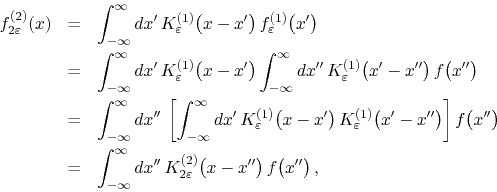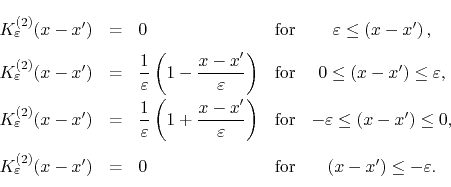Next: Application in Partial Differential Up: The Low-Pass Filters on Previous: The Low-Pass Filters on
Since the first-order filter defined here is linear, one can construct
higher-order filters by simply applying it multiple times to a given real
function. Consider the first-order filter of range ![]() written
in terms of the first-order kernel,
written
in terms of the first-order kernel,
where the first-order kernel is given, now in full detail, by the piece-wise description
Note that, although this is not important for its operation, at the points
of discontinuity we define the value of the kernel as the average of the
two lateral limits to that point. These are the values to which its
Fourier series converges at these points. With this the kernel can also be
given by the Fourier representation within ![]() , if
, if
![]() ,
,
![\begin{displaymath}
K_{\varepsilon}^{(1)}\!\left(x-x'\right)
=
\frac{1}{2\pi}...
...\varepsilon)}
\right]
\cos\!\left[k\left(x-x'\right)\right].
\end{displaymath}](img41.png)
Using the representation in terms of an integral operator it is easy to
compose two instances of the first-order filter in order to obtain a
second-order one, with range ![]() ,
,

where the second-order kernel with range ![]() is given by the
application of the first-order filter to the first-order kernel,
is given by the
application of the first-order filter to the first-order kernel,
It is not difficult to show by direct calculation of the integral that this second-order kernel is given by the piece-wise description

which makes its range explicit. It is also given by the Fourier
representation within ![]() , so long as
, so long as
![]() ,
,
![\begin{displaymath}
K_{2\varepsilon}^{(2)}\!\left(x-x'\right)
=
\frac{1}{2\pi...
...epsilon)}
\right]^{2}
\cos\!\left[k\left(x-x'\right)\right].
\end{displaymath}](img47.png)
The calculation of the coefficients of this series is just as
straightforward as the one for the first-order kernel. Due to the factor
of ![]() in the denominator, this series is absolutely and uniformly
convergent over the whole periodic interval. The result shown above also
follows from the property of the first-order filter regarding its action
on Fourier expansions, listed as item 12 on
page
in the denominator, this series is absolutely and uniformly
convergent over the whole periodic interval. The result shown above also
follows from the property of the first-order filter regarding its action
on Fourier expansions, listed as item 12 on
page ![]() , which is demonstrated in
Section A.12 of Appendix A. Note that,
according to the property listed as item 9 on
page
, which is demonstrated in
Section A.12 of Appendix A. Note that,
according to the property listed as item 9 on
page ![]() , which is demonstrated in
Section A.9 of Appendix A, the first-order
filter does not change the definite integral of the compact-support
function it is applied on, and since
, which is demonstrated in
Section A.9 of Appendix A, the first-order
filter does not change the definite integral of the compact-support
function it is applied on, and since
![]() is an even function with unit
integral and compact support, it follows that
is an even function with unit
integral and compact support, it follows that
![]() is also an even function with
unit integral and compact support, since it is given by the first-order
kernel
is also an even function with
unit integral and compact support, since it is given by the first-order
kernel
![]() filtered by the
first-order filter.
filtered by the
first-order filter.
The range of the first-order filter, within which the functions are
significantly changed by it, is given by ![]() , and if one just
applies the filter twice, as we did above, that range doubles do
, and if one just
applies the filter twice, as we did above, that range doubles do
![]() . However, one may compensate for this by simply applying
twice the first-order filter with parameter
. However, one may compensate for this by simply applying
twice the first-order filter with parameter ![]() , thus
resulting in a second-order filter with range
, thus
resulting in a second-order filter with range ![]() . In this way
one may define higher-order filters while keeping the relation of the
range to the relevant physical scale constant. For example, we have the
second-order filter with range
. In this way
one may define higher-order filters while keeping the relation of the
range to the relevant physical scale constant. For example, we have the
second-order filter with range ![]() defined by the kernel
defined by the kernel
It is immediate to obtain the piece-wise description of this kernel from
that of
![]() ,
,

It is equally immediate to obtain the Fourier representation of this
kernel within ![]() , which so long as
, which so long as
![]() is given
by
is given
by
![\begin{displaymath}
K_{\varepsilon}^{(2)}\!\left(x-x'\right)
=
\frac{1}{2\pi}...
...silon/2)}
\right]^{2}
\cos\!\left[k\left(x-x'\right)\right].
\end{displaymath}](img54.png)
This procedure can be iterated ![]() times to produce an order-
times to produce an order-![]() filter.
One can verify on a case-by-case fashion that such a filter is given by a
piece-wise kernel formed of polynomials of order
filter.
One can verify on a case-by-case fashion that such a filter is given by a
piece-wise kernel formed of polynomials of order ![]() on
on ![]() equal-length
intervals between
equal-length
intervals between ![]() and
and ![]() , each interval of
length
, each interval of
length ![]() , with the polynomials connected to each other in a
maximally smooth way. Since the filter of order
, with the polynomials connected to each other in a
maximally smooth way. Since the filter of order ![]() is obtained by the
application of the first-order filter to the result of the filter of order
is obtained by the
application of the first-order filter to the result of the filter of order
![]() , it follows that the kernel of order
, it follows that the kernel of order ![]() is the kernel of order
is the kernel of order
![]() filtered by the first-order filter. Due to this, and recalling again
the property of the first-order filter regarding its action on Fourier
expansions, listed as item 12 on page
filtered by the first-order filter. Due to this, and recalling again
the property of the first-order filter regarding its action on Fourier
expansions, listed as item 12 on page ![]() ,
the Fourier representation of the order-
,
the Fourier representation of the order-![]() kernel of range
kernel of range ![]() can be easily written explicitly,
can be easily written explicitly,
![\begin{displaymath}
K_{N\varepsilon}^{(N)}\!\left(x-x'\right)
=
\frac{1}{2\pi...
...epsilon)}
\right]^{N}
\cos\!\left[k\left(x-x'\right)\right],
\end{displaymath}](img59.png)
so long as
![]() . This expression can be extended to the
case
. This expression can be extended to the
case ![]() , which corresponds to an order-zero filter that has the Dirac
delta ``function'' as its kernel, since the delta ``function'' can be
represented by the divergent series
, which corresponds to an order-zero filter that has the Dirac
delta ``function'' as its kernel, since the delta ``function'' can be
represented by the divergent series
![\begin{eqnarray*}
\delta\!\left(x-x'\right)
& = &
K_{0}^{(0)}\!\left(x-x'\rig...
...pi}
\sum_{k=1}^{\infty}
\cos\!\left[k\left(x-x'\right)\right],
\end{eqnarray*}](img62.png)
as is discussed in detail in [2]. We see in this way that the
first-order kernel
![]() can in fact
be obtained by the application of the first-order filter to the delta
``function'', as is discussed in more detail in Section A.5
of Appendix A.
can in fact
be obtained by the application of the first-order filter to the delta
``function'', as is discussed in more detail in Section A.5
of Appendix A.
In this construction the range of the filter increases with ![]() , so that
one cannot iterate in this way indefinitely inside the periodic interval
without the range eventually becoming larger than the length of the
interval. However, we may keep the overall range constant at the value
, so that
one cannot iterate in this way indefinitely inside the periodic interval
without the range eventually becoming larger than the length of the
interval. However, we may keep the overall range constant at the value
![]() by decreasing the range of the first-order filter at each
level of iteration, that is, by iterating
by decreasing the range of the first-order filter at each
level of iteration, that is, by iterating ![]() times the first-order filter
of range
times the first-order filter
of range ![]() . If we simply exchange
. If we simply exchange ![]() for
for
![]() in the expression above we get the order-
in the expression above we get the order-![]() kernel with
range
kernel with
range ![]() , written in quite a simple way in terms of its Fourier
expansion,
, written in quite a simple way in terms of its Fourier
expansion,
![\begin{displaymath}
K_{\varepsilon}^{(N)}\!\left(x-x'\right)
=
\frac{1}{2\pi}...
...silon/N)}
\right]^{N}
\cos\!\left[k\left(x-x'\right)\right],
\end{displaymath}](img64.png)
 |
so long as
![]() . Since the range is now constant, one can
consider iterations of any order
. Since the range is now constant, one can
consider iterations of any order ![]() , without any upper bound, even within
the periodic interval. Note that this series converges ever faster as
, without any upper bound, even within
the periodic interval. Note that this series converges ever faster as ![]() increases. Note also that it can be differentiated
increases. Note also that it can be differentiated ![]() times still
resulting in a absolutely and uniformly convergent series, and
times still
resulting in a absolutely and uniformly convergent series, and ![]() times
still resulting in a point-wise convergent series. This is a reflection of
the fact that the polynomials that compose the kernel are connected to
each other in the maximally smooth way. Apart from the case of the
order-zero kernel, which has a divergent Fourier series, the series for
times
still resulting in a point-wise convergent series. This is a reflection of
the fact that the polynomials that compose the kernel are connected to
each other in the maximally smooth way. Apart from the case of the
order-zero kernel, which has a divergent Fourier series, the series for
![]() is the only one which is not
absolutely or uniformly convergent, although it is point-wise convergent.
For
is the only one which is not
absolutely or uniformly convergent, although it is point-wise convergent.
For ![]() all the kernel series are absolutely and uniformly
convergent to functions of differentiability class
all the kernel series are absolutely and uniformly
convergent to functions of differentiability class ![]() everywhere.
The kernels of the filters of the first few orders, with constant range
everywhere.
The kernels of the filters of the first few orders, with constant range
![]() , are shown in Figure 1. The program used to plot
this graph is available online [4].
, are shown in Figure 1. The program used to plot
this graph is available online [4].
As we saw above, the order-![]() kernels are themselves a good example of
the smoothing action of the filters. As we verified in that case, the use
of higher-order filters will have the effect of introducing more powers of
kernels are themselves a good example of
the smoothing action of the filters. As we verified in that case, the use
of higher-order filters will have the effect of introducing more powers of
![]() in the denominators of the Fourier coefficients
in the denominators of the Fourier coefficients ![]() and
and
![]() , and hence of making the Fourier series converge faster and to
smoother functions. This will then enable one to take a certain number of
term-wise derivatives of the series, as may be required by the
applications involved. Besides, all this can be done within a small
constant length scale determined by
, and hence of making the Fourier series converge faster and to
smoother functions. This will then enable one to take a certain number of
term-wise derivatives of the series, as may be required by the
applications involved. Besides, all this can be done within a small
constant length scale determined by ![]() , leaving essentially
untouched the description of the physics at the larger scales.
, leaving essentially
untouched the description of the physics at the larger scales.